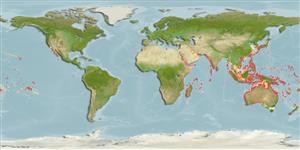Common names from other countries
Classification / Names / Names
Nomi Comuni | Sinonimi | Catalog of Fishes (gen., sp.) | ITIS | CoL | WoRMS
Environment: milieu / climate zone / depth range / distribution range
Ecologia
Associati a barriera corallina; distribuzione batimetrica 0 - 40 m (Ref. 848), usually 12 - 15 m (Ref. 98471). Tropical; 54°N - 44°S, 25°E - 110°W (Ref. 848)
Indo-Pacific: Japan to Australia and South Africa to Easter Island.
Length at first maturity / Size / Peso / Age
Maturity: Lm ? range ? - ? cm
Oval walls of the corallites are closely set, slightly plocoid, and variable in details of septa and costae. Either bright green or brown, with a lighter oral disc.
In most reef environments, including shaded environments such as under overhangs. Subtidal. Also occurs in rocky foreshores protected from strong wave exposure, on the back and foreslope of reef, in lagoons and outer reef channel (Ref. 98471). Polyps extend during daytime (Ref. 130769).
Life cycle and mating behavior
Maturità | Riproduzione | Deposizione | Uova | Fecundity | Larve
Members of the class Anthozoa are either gonochoric or hermaphroditic. Mature gametes are shed into the coelenteron and spawned through the mouth. Life cycle: The zygote develops into a planktonic planula larva. Metamorphosis begins with early morphogenesis of tentacles, septa and pharynx before larval settlement on the aboral end.
Veron, J.E.N. and G. Hodgson. 1989. (Ref. 8817)
IUCN Red List Status (Ref. 130435)
CITES status (Ref. 108899)
Not Evaluated
Human uses
| FishSource |
Strumenti
Informazioni ulteriori
Age/SizeAccrescimentoLength-weightLength-lengthMorfologiaLarveAbbondanza
Fonti Internet
Estimates based on models
Preferred temperature
(Ref.
115969): 21.8 - 29.2, mean 28 (based on 3278 cells).
Price category
Unknown.
